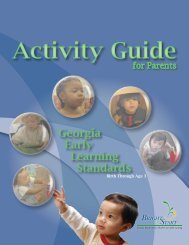Georgia's Pre-K Program - FPG Child Development Institute ...
Georgia's Pre-K Program - FPG Child Development Institute ...
Georgia's Pre-K Program - FPG Child Development Institute ...
Create successful ePaper yourself
Turn your PDF publications into a flip-book with our unique Google optimized e-Paper software.
Georgia Study of Early Care and Education: Findings from Georgia’s <strong>Pre</strong>-K <strong>Program</strong><br />
learning activities. Learning activities could occur within any of the activity settings<br />
described above (e.g., whole group, free choice) and either inside or outside. <strong>Child</strong>ren’s<br />
engagement in learning activities was coded as one or more of the following:<br />
• Literacy (child is being read to by an adult, exploring books on his/her own or with<br />
peers, learning about letters/sounds, or involved in activities where the teacher is<br />
trying to build expressive language)<br />
• Math (any activity involving counting, time, shapes, sorting)<br />
• Science (activities involving exploring and learning about the environment, science<br />
equipment, animals, body parts, food/nutrition, etc.)<br />
• Social studies (child is talking, reading, or engaged in activities about their world<br />
including issues related to culture, family, or their school. Dramatic/pretend play and<br />
block play are counted here.)<br />
• Art (child is engaged in art or music activities)<br />
• Fine motor (e.g., stringing beads, completing puzzles, using markers)<br />
• Gross motor (activities involving movement of the whole body)<br />
Table 5. Percentage of Time <strong>Child</strong>ren Spent in Various Learning Activities<br />
Centers Schools<br />
Literacy 17% 17%<br />
Math 15% 15%<br />
Science 8% 8%<br />
Social Studies 18% 16%<br />
Art 25% 15%<br />
Fine Motor 9% 7%<br />
Gross Motor 7% 6%<br />
Note: <strong>Child</strong>ren could be in more than one learning activity at the same time. For instance, if a child were looking at a<br />
book about planets, that was coded as both “literacy” and “science.” Therefore, the codes in this table should not be<br />
added together.<br />
Finally, for each 20-second observation, the data collectors indicated if the target child<br />
was individually engaged with the teacher or if she/he was a participant in the group with<br />
which the teacher was working. Georgia’s <strong>Pre</strong>-K children interacted with an adult 47% of<br />
the time in center-based programs and 48% of the time in school-based programs.<br />
Education and Professional <strong>Development</strong><br />
This section of the report provides information about the highest level of education,<br />
major, years of experience, and in-service training for program administrators, lead<br />
teachers, and assistant teachers. In centers, the “Director/Principal” questions were<br />
asked of the individual who ran the program. In schools, the “Director/Principal”<br />
questions were asked of the individual who supervised Georgia’s <strong>Pre</strong>-K teachers. This<br />
13
















